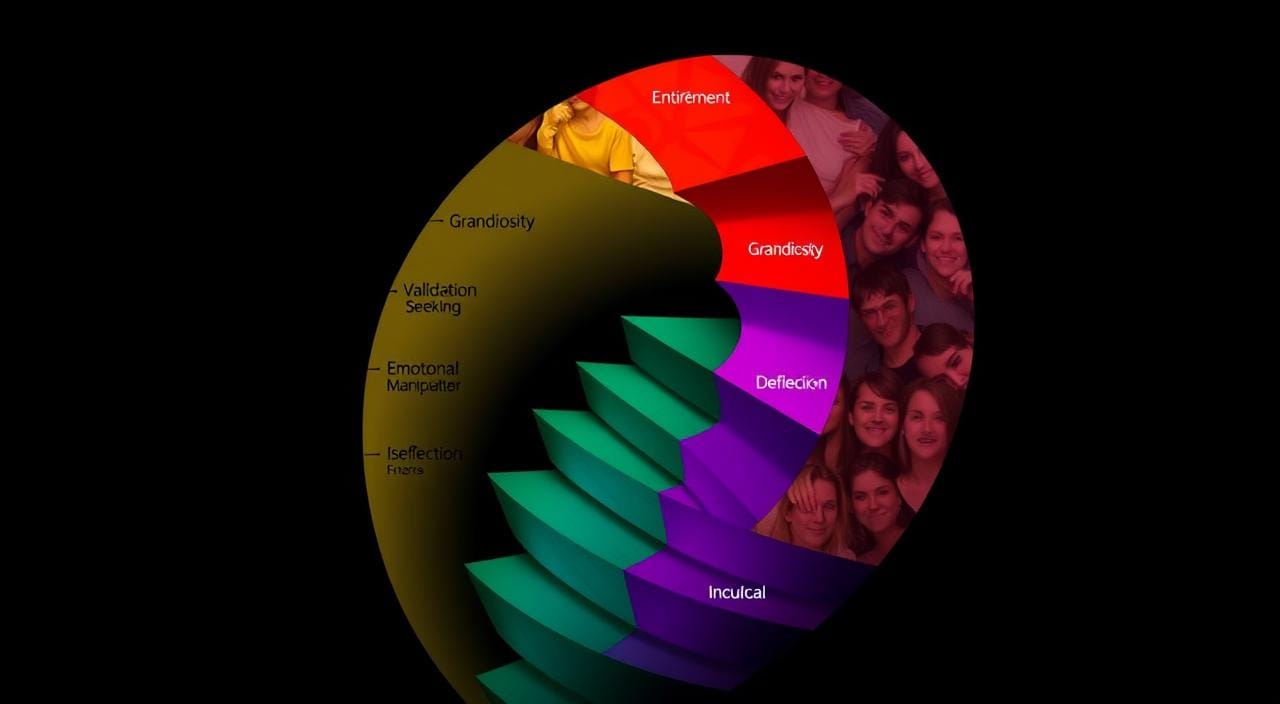Navigating narcissistic relationships can be tough, especially when dealing with “narcissist hoovering.” This behavior makes us feel vulnerable. It’s when a narcissist tries to pull us back into their toxic world1. Let’s dicuss narcissist hoovering after no contact.
If you’ve been hurt by a narcissist and then they come back, you’re not alone. They crave constant attention and will use tricks to get it back. This happens even after you’ve cut ties2.
Key Takeaways
- Narcissists use hoovering tactics to maintain control and feed their need for validation
- Hoovering can involve lies, deception, and even attempts to sabotage your new relationships
- Resist the temptation to idealize your past relationship or fall for the narcissist’s false promises
- Implementing and maintaining a strict no-contact policy is crucial for breaking the cycle of narcissistic abuse
- Seek support and professional help to heal and move forward after a narcissistic relationship
We’ll explore narcissist hoovering in this article. We’ll look at their tactics, why they do it, and how to protect yourself. Understanding their mindset helps us heal and regain our power3.
Understanding Narcissist Hoovering
Hoovering is when narcissists try to get back with someone they’ve lost contact with4. They do this because they fear being left alone and feel not good enough4. Dr. Daramus says narcissists use hoovering to keep control and boost their ego4.
What is Hoovering?
Hoovering is a way narcissists try to pull someone back into a relationship5. They use tricks to keep power and control5. It usually happens after they’ve pushed someone away5.
Tactics Used by Narcissists for Hoovering
Narcissists use tricks like being overly loving and making threats to keep control4. They might try to stop someone from leaving or get them to come back5. They use fake love, promises, guilt, and even other people to get to their victim5.
They might do this to get attention, make someone feel guilty, or because they’re scared of being alone5.
To deal with hoovering, stay away, set clear limits, and focus on yourself5. Don’t let them manipulate you and get help if you feel threatened5.
Knowing about hoovering helps you see and avoid their tricks45. By understanding their motives, you can protect yourself and escape the abuse45.
Reasons Why Narcissists Hoover After No Contact
Narcissists often use the tactic of “hoovering” after no contact. This is because of their hurt pride and fear of being rejected6. When someone cuts off contact, it hurts their ego, making them feel rejected and losing control6. They are very sensitive to any slight and will do a lot to regain their pride and self-esteem6.
Hurt Pride and Ego
A narcissist’s ego is very fragile. Being left or ignored can shatter their self-image6. They might try to get their ex back into the relationship. This is not because they truly want to change, but to control the situation again6.
They use tricks like rewriting history, acting like nothing’s wrong, and making false apologies. They even get others to contact the victim for them6.
Fear of Rejection
The fear of being rejected terrifies narcissists. It challenges their belief in their own importance and their right to attention6. People who have been abused by narcissists often find it hard to say no to them6.
However, research shows6 that staying silent and not contacting them is the best way to stop their behavior6.
Narcissists look for “supply” to fill their emptiness, without caring for real connections6. Those who have left a narcissist should remember why they did it. They should protect themselves from harmful relationships6.
To understand narcissistic hoovering better, check out Narcissism Exposed7 and Psychcentral6.

“Narcissists hate to lose what they’ve ensnared, wanting to keep every person they’ve trapped and collected since childhood.”7
Narcissists hoover for three main reasons: to keep getting “goodies,” to watch the victim, and because they don’t like to lose their prey7. Watching the victim is key to keeping their image intact and preventing exposure7. They also hoover to get a new partner or living situation and to stop the victim from ruining their reputation7.
In short, narcissists hoover because of their hurt pride and fear of rejection. They want to regain control and keep their superiority678. It’s important for victims to set boundaries and protect themselves from these manipulative tactics8.
Narcissist Hoovering After No Contact to Maintain Control
Narcissists use a tactic called “hoovering” to get back control after no contact9. This is because they need to keep power and control in their relationships10. When they lose contact, they feel like they’ve lost control. They try to get it back using different hoovering methods.
Hoovering helps the narcissist show they’re in charge. They play with the victim’s feelings to regain their top spot9. This is because they feel they must always be in control. They can’t handle being seen as weak or unimportant10.
Narcissists might use love bombing to win the victim back9. They also use gaslighting to make the victim question their own sanity9. They might promise to change, apologize, or even show off new partners to make the victim jealous11.
The effects of narcissistic hoovering can be very hard to deal with9. Victims might feel confused, anxious, drained, betrayed, angry, hurt, and less of themselves9. It’s important for them to focus on healing. They should get help from therapists, coaches, and support groups. They also need to take care of themselves and set clear boundaries9.

The narcissist’s drive for control and validation leads to hoovering10. By understanding this, victims can handle the complex and draining cycle of narcissistic abuse and hoovering better11.
The Narcissist’s Need for Narcissistic Supply
Narcissists crave attention, admiration, and validation from others. This is their emotional fuel, essential for their fragile self-image. Without it, they feel empty and inadequate12.
Emotional Survival of the Narcissist
Narcissists find it hard to be alone and reflect on themselves. They avoid their inner struggles by using tactics like hoovering. This keeps them supplied with emotional support12.
Lack of Ability to Be Alone
The fear of being alone drives their hoovering. They need constant attention and validation. Hoovering helps them feel secure, even if it harms others12.
| Narcissist’s Hoovering Tactics | Frequency of Use |
|---|---|
| Saying “I miss you” | High13 |
| Fake apologies | Prevalent13 |
| Gaslighting | Prevalent13 |
| Making promises | Prevalent13 |
Narcissists use many tactics to hoover, like saying “I miss you,” fake apologies, and gaslighting13. These actions stem from their need for attention and validation. They can’t get this without someone to supply them emotionally12.
“Narcissists often lack the ability to self-reflect and be alone, finding solitude deeply uncomfortable.”
Understanding the narcissist’s fear of being alone and their need for supply is key. This knowledge helps us deal with their manipulation and focus on our own well-being121314.
Hoovering When the Victim Moves On
Narcissists often try to hoover when they see their victim happy with someone else. Seeing their former partner in a new relationship makes them feel jealous and possessive. They might try to ruin the new relationship in many ways, like showing up unexpectedly or spreading lies3. This is their way of trying to get back control and stop the victim from being happy without them.
Jealousy and Possessiveness
Narcissists fear being left behind and need to control everything. When their victim moves on, they feel jealous and want to get back their supply15. They might do anything to mess up the new relationship, using tricks and lies to make the victim unhappy again.
Sabotaging New Relationships
Narcissists are experts at ruining new relationships for their victims. They might spread false rumors, contact the victim’s new partner, or even try to win the victim back3. Their goal is to keep control and stop the victim from being happy with someone else, keeping their emotional grip on the victim.
| Tactics Used by Narcissists for Hoovering | Description |
|---|---|
| Flying Monkeys | Using friends, family, or colleagues to draw the victim back in16 |
| Future Faking | Making false promises about the future to maintain a bond and extract admiration from the victim16 |
| Gaslighting | Denying their actions and manipulating the victim’s sense of reality16 |

“Hoovering,” a term used to describe a narcissist trying to reconnect after a period of separation, typically occurs during times of silence between the victim and the narcissist15.
Victims of narcissistic abuse need to know these narcissist hoovering tactics and take care of themselves. They should set strong boundaries and get help from professionals16. By focusing on self-care and growth, they can escape the narcissist’s trap and find true happiness.
Narcissist Hoovering After No Contact: What to Know
Understanding narcissist hoovering is key for those who’ve been in a narcissistic relationship. Hoovering is when narcissists try to pull their victims back into abuse, even after they’ve had no contact17. This usually happens when the narcissist is between 19 and 40 years old17.
Narcissists might use guilt trips, surprise visits, or reminders of good times to control their victims17. They do this to keep their power and avoid feeling rejected or having a damaged ego17.
Hoovering is more about the narcissist’s needs than real love15. About 60 million people suffer from narcissistic abuse, but only a few leave on their own17.
Knowing the signs of narcissist hoovering helps victims stay safe and regain their self-worth15. The goal is to fully detach from the narcissist to end abuse and grow personally15.

By knowing why and how narcissists hoover, victims can protect themselves and set healthy boundaries18. Hoovering is about the narcissist’s needs, not real love, and is a big part of abusive cycles15.
- Narcissists might use guilt trips, surprise visits, or reminders of happier times to lure victims back17.
- Narcissists may hoover after no contact due to pride, rejection, control, loneliness, and feeling the relationship is failing17.
- Narcissists hoover to regain control over the victim’s emotions and maintain power in the relationship17.
It’s important to remember that people with Narcissistic Personality Disorder rarely change15. Victims of narcissistic abuse may face more cruelty if they go back to the narcissist15.
“Hoovering” plays a significant role in the cycle of violence in abusive relationships, with the abuse intensifying over time15.
By understanding narcissist hoovering, individuals can protect themselves and maintain healthy boundaries. This helps them break free from abuse and regain their self-worth and autonomy18.
Hoovering as a Power Play
For many narcissists, hoovering is a way to show their power. They see relationships as a way to get what they want from others. Narcissists often view relationships as transactions, where they get as much attention as they can19.
When someone tries to leave, the narcissist feels threatened. They start hoovering to get back in control. This way, they can feel better about themselves and keep using the other person’s emotions20.
Relationships as Transactions
To narcissists, relationships are like deals. They give attention and affection to get love and admiration in return. When someone wants to leave, they use hoovering to pull them back20.
Regaining Self-Esteem and Power
Hoovering helps narcissists feel better about themselves. It lets them regain power and control. They do it because they need to feel important and avoid feeling vulnerable20.

“Narcissists often view relationships as transactions, where they seek to extract as much narcissistic supply as possible from their partners.”
| Tactic | Explanation |
|---|---|
| Hoovering as a Power Play | Narcissists use hoovering to reassert their dominance and control over their victim, perceiving the victim’s attempt to leave as a threat to their power. |
| Relationships as Transactions | Narcissists view relationships as a series of transactions where they exchange attention and affection for adoration and narcissistic supply. |
| Regaining Self-Esteem and Power | By successfully hoovering a victim back into the relationship, the narcissist can temporarily boost their fragile self-esteem and reclaim a sense of power and control. |
In summary, hoovering is a way for narcissists to show their power. They see relationships as deals and try to get back in control by pulling victims back in1920.
The Cycle of Narcissistic Abuse and Hoovering
Understanding narcissist hoovering is key to grasping the cycle of narcissistic abuse21. This cycle has four phases: idealization, devaluation, discard, and hoovering21. In the idealization phase, the narcissist showers the victim with love and gifts to control them21. Then, in the devaluation phase, the narcissist becomes emotionally and verbally abusive, hurting the victim’s self-esteem21.
Calm, Tension, Abuse, and Reconciliation
After the discard phase, the narcissist may start hoovering2122. Hoovering is a way to pull the victim back into the abuse, using false promises and guilt21. The relationship can quickly switch between these phases, showing the narcissist’s need for control22.
Escalating Cruelty After Hoovering
When the victim tries to leave, the narcissist may hoover to regain control21. But, the abuse often gets worse after the victim is pulled back in21. The narcissist may use gaslighting and chaos to control the victim22. Knowing this cycle helps us avoid falling into the hoovering trap.
Understanding narcissistic abuse and hoovering is crucial. By staying informed and seeking support, we can break free and reclaim our lives.
| Phases of Narcissistic Abuse Cycle | Characteristics |
|---|---|
| Idealization | Narcissist showering the victim with love, attention, and gifts to manipulate them21. |
| Devaluation | Narcissist becoming emotionally and verbally abusive, undermining the victim’s self-esteem and confidence21. |
| Discard | Narcissist abruptly moving on to a new source of ego supply, leaving the victim emotionally devastated21. |
| Hoovering | Narcissist using manipulation tactics to lure the victim back into the abusive cycle, often through false promises, fake apologies, and guilt-tripping21. |
“Hoovering is generally abusive in nature, aimed at luring the victim’s attention, and can be carried out with intentional or unintentional behaviors.” – Antonia Di Leo, LMFT23
By understanding the cycle of narcissistic abuse and hoovering, we can protect ourselves. Maintaining boundaries, prioritizing self-care, and seeking support are crucial steps in breaking free from the narcissist’s control and moving towards a healthier, more fulfilling life.23
Dealing with Narcissist Hoovering
When a narcissist tries to pull you back in, it’s key to have a solid plan to protect yourself. The best way is to stick to no contact, cutting off all communication24. This move stops the abuse cycle and takes away the narcissist’s need for attention15.
Maintaining No Contact
Keeping no contact is vital when dealing with a narcissist’s pull. You must block all communication, like phone calls, texts, emails, and social media15. By ignoring their attempts to reconnect, you shield yourself from their emotional games and manipulation.
Becoming a “Gray Rock”
Along with no contact, being a “gray rock” can also help. This means being emotionally unresponsive and uninteresting to the narcissist15. By being dull and unreactive, you make yourself less appealing to them. This helps you regain control and focus on healing.
Remember, the narcissist’s pull is not about your worth but their need for control15. By taking care of yourself, setting clear boundaries, and not getting pulled back in, you can escape the abuse cycle and take back your life.
“Healthy relationships do not involve cheating, lying, manipulation, gaslighting, verbal abuse, insults, passive-aggressive behavior, or praising one day and tearing down the next.”24
| Effective Strategies | Benefits |
|---|---|
| Maintain strict no contact | Break the cycle of abuse, deprive the narcissist of attention and validation |
| Adopt the “gray rock” method | Become emotionally unresponsive and uninteresting to the narcissist |
| Prioritize self-care and healing | Regain power and focus on your own recovery |
Healing and Moving Forward
Getting over narcissistic abuse takes a lot of effort and growth. Restoring self-trust, lost due to gaslighting, is key25. Narcissists use guilt to lower a person’s confidence and self-worth. It’s vital to rebuild these.
Restoring Self-Trust
To trust yourself again, you must face the abuse and its effects. Start by changing negative thoughts and setting boundaries26. Healing means cutting ties with the abuser, especially if children are involved.
Professional Help and Support
Therapy or support groups offer great help in healing26. The Gray Rock method and setting boundaries can manage interactions with abusers. Therapists teach coping and help regain power26. Techniques like “bookending” protect against narcissistic draining.
Focus on self-care, set boundaries, and rebuild self-worth to escape the narcissist’s control25. When victims set no contact, narcissists may resist, manipulate, or try to pull them back.
“Healing is not linear. It is a journey of ups and downs, ebbs and flows. Be patient and compassionate with yourself as you navigate this process.”
| Key Strategies for Healing from Narcissistic Abuse | Benefits |
|---|---|
| Establishing No Contact or Minimal Contact | Reduces exposure to the narcissist’s manipulation and control |
| Seeking Professional Help (Therapy, Support Groups) | Provides guidance, coping strategies, and a safe space to heal |
| Rebuilding Self-Trust and Self-Worth | Regains a positive self-perception and sense of empowerment |
| Practicing Self-Care and Boundary Setting | Promotes emotional and psychological well-being |
By following these steps, you can start healing from narcissistic abuse. You’ll regain self-trust and seek help to reclaim your life2526.
Conclusion
Narcissist hoovering after no contact is a way for people with narcissistic personality disorder to get back in control. They do this to keep getting the emotional support they crave. By knowing why they do this, like to avoid feeling hurt or rejected, we can spot and handle their attempts better.
Keeping strict no contact, being a “gray rock,” and focusing on self-care and getting professional help are key. Research shows narcissists use different ways to try to get back in touch. They might get different reactions from their victims, and it might not always work for them.
Hoovering is not about the narcissist wanting to change or make amends. It’s their way to meet their own emotional needs, even if it hurts their victims. By being careful and looking after ourselves, we can take back our power. This helps us break the trauma bond and move towards a better future. The main lessons are to watch out for signs, protect ourselves, and get the help we need to heal and grow.
FAQ
What is narcissist hoovering?
Hoovering is when a narcissist tries to get back in touch with someone they’ve hurt or left. They use tricks like remembering good times, pretending to be sick, or showing up without warning.
Why do narcissists hoover after no contact?
Narcissists hoover for many reasons. They might feel hurt, scared of being rejected, or want to keep control. They also do it to get attention and praise, which they call narcissistic supply.
How do narcissists use hoovering as a power play?
Hoovering is a way for narcissists to show they’re in charge. They see relationships as a way to get what they want, like attention and praise.
How does the cycle of narcissistic abuse relate to hoovering?
Hoovering is part of a bigger pattern of abuse. It happens when a victim tries to leave, and the narcissist tries to pull them back. This cycle includes calm times, tension, abuse, and making up.
How can victims protect themselves from narcissist hoovering?
The best way is to stay away completely and not talk to the narcissist. Being uninteresting and unresponsive, like a gray rock, can also help stop them.
How can victims focus on healing and moving forward after narcissist hoovering?
Victims need to heal and grow after being hurt by a narcissist. They should work on rebuilding trust and seeking help. Therapy or support groups can offer valuable support.
Source Links
- 6 Remedies When Narcissists Won’t Let Go | What Is Codependency? – https://whatiscodependency.com/hoovering-when-narcissists-wont-let-go/
- What Is Narcissist Hoovering? 18 Worrying Signs It’s Happening to You – Learning Mind – https://www.learning-mind.com/narcissist-hoovering-signs/
- A Narcissist Always Returns (the Hoovering) – https://www.thenarcissisticpersonality.com/narcissist-returns-hoovering/
- The Manipulative Tactics of Narcissists: Hoovering Explained – https://www.verywellmind.com/narcissistic-hoovering-8407338
- Narcissistic Hoovering: Signs & How to Respond – https://www.simplypsychology.org/narcissistic-hoovering-signs-how-to-respond.html
- Narcissistic and Family Scapegoat Recovery – https://www.laurakconnell.com/blog/hoovering
- Hoovering Happens: Understand What’s Up – true love scam recovery – https://www.truelovescam.com/hoovering-happens/
- Hoovering: Definition, Signs, and Coping Tips – https://psychcentral.com/relationships/hoovering
- Narcissistic Hoovering: How to Stop the Emotional Rollercoaster – https://www.narcissisticabuserehab.com/narcissistic-hoovering/
- Exactly Why the Narcissist Comes Back After Months – https://kimsaeed.com/2014/02/08/the-real-reason-the-narcissist-comes-back-after-no-contact/
- Narcissistic Hoovering: How They Reel You Back In And How To Avoid It – Sallt Sisters – https://salltsisters.com/narcissistic-hoovering-how-they-reel-you-back-in-and-how-to-avoid/
- Hoovering | How Narcissists Try to Suck You Back In – https://medium.com/@OwnYourReality/hoovering-how-narcissists-try-to-suck-you-back-in-fe46bc380c2c
- A Primer in Narcissistic Hoovering – https://medium.com/invisible-illness/a-primer-in-narcissistic-hoovering-5e2fdf652bdb
- 7 Facts to Know About Narcissistic “Hoovering” – https://www.psychologytoday.com/us/blog/here-there-and-everywhere/202209/7-facts-know-about-narcissistic-hoovering
- Hoovering – How The Narcissist Tricks You Into Breaking No Contact – https://blog.melanietoniaevans.com/hoovering-how-the-narcissist-tricks-you-into-breaking-no-contact/
- Understanding The Narcissist Can Set You Free — Jessica Anne Pressler .lcsw – https://www.jessicaannepressler.com/blog/blog-series-part-5-future-faking-gray-rock-and-hoovering
- SIX SAD REASONS WHY THE NARCISSIST IS HOOVERING YOU AFTER NO CONTACT – https://barkhadlekhalif.medium.com/six-sad-reasons-why-the-narcissist-is-hoovering-you-after-no-contact-360e35967ba8
- What Is Hoovering? 7 Signs and How To Handle It – https://health.clevelandclinic.org/hoovering
- Hoovering Narcissist: Definition, Examples, & How to Respond – https://www.wikihow.com/Hoovering-Narcissist
- ‘Hoover Maneuver’: The Dirty Secret of Emotional Abuse – GoodTherapy.org Therapy Blog – https://www.goodtherapy.org/blog/hoover-maneuver-the-dirty-secret-of-emotional-abuse-0219154/
- The 4 Phases Of The Narcissist Abuse Cycle | Florida Women’s Law Group – https://www.floridawomenslawgroup.com/blog/the-4-phases-of-the-narcissist-abuse-cycle/
- How the narcissist hooks you: Hoovering & baiting – https://narcwise.com/2019/01/20/narcissist-hooks-hoovering-baiting/
- Getting This Kind Of Text From Your Ex Is A Big Red Flag – https://www.mindbodygreen.com/articles/hoovering-in-relationships
- Why a Narcissist Does NOT Hoover – https://www.stephanielynlifecoaching.com/blog/why-a-narcissist-does-not-hoover
- 7 Tactics to Tackle During No Contact With a Narcissist – https://www.marriage.com/advice/mental-health/things-narcissists-do-when-you-go-no-contact/
- Detecting and Healing from Narcissistic Abuse — Resolve – https://www.kcresolve.com/blog/detecting-and-healing-from-narcissistic-abuse







